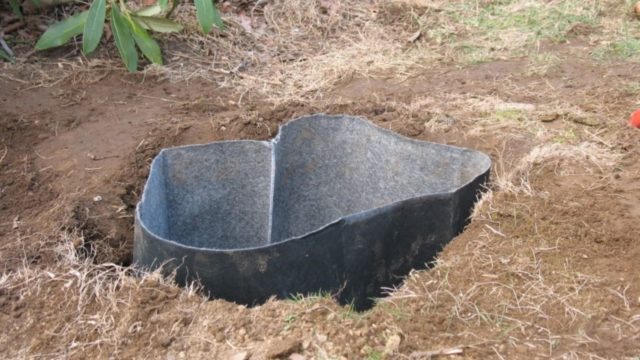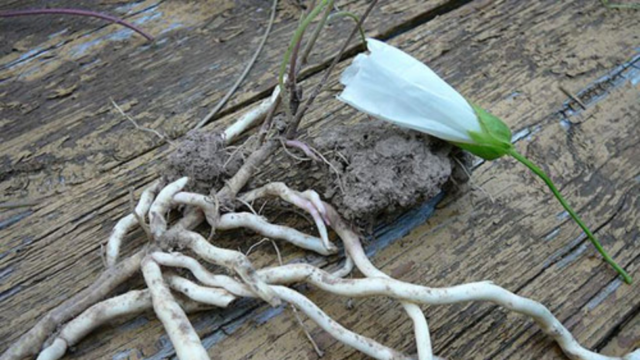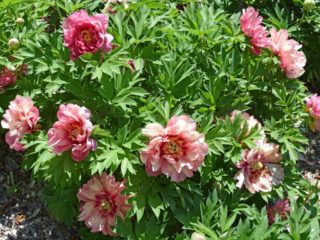Content
Calystegia is a decorative vine of the Convolvulaceae family. This plant is ideal for vertical gardening, which is why it is often used in landscape design. Its popularity among gardeners is explained by its hardiness, ease of care, rapid growth and high decorative value throughout the season. Japan and China are considered the birthplace of calistegia or rootstock; it can also be found in natural conditions in the Far East, where the vine grows everywhere. Planting and caring for Calistegia is carried out taking into account the requirements of the culture, otherwise the desired result will not be achieved.

Liana easily adapts to any climatic conditions
Botanical description
This plant is a herbaceous perennial. Its climbing shoots reach a height of 4 m. Their surface is brown. The stems of the vine are smooth, flexible, but strong.The leaves of the rootstock can be bud-shaped, ovate or triangular with a heart-shaped base. The plates are bright green in color with a pronounced relief pattern on the surface of veins. They are located alternately along the entire length of the shoots and are secured by petioles.
The calistegia plant is distinguished by a well-developed creeping root that can grow up to 1.5 m in length. Every year, with the onset of autumn frosts, the above-ground part completely dies off. And with the arrival of spring, the liana begins its growth from restoration buds, which are located in the upper part of the root system.
Along the entire length of the vine shoots, single flowers are formed throughout the season, which appear from the axils of the leaves. They can be white or pink. The flowers are bell-shaped and, depending on the species, can be single or double. Their diameter can also vary from 2 to 9 cm. The flowers consist of 5 delicate petals that are fused together and frame a tubular core with stamens.
After the buds wither, a four-leaf round fruit is formed, inside of which the seeds ripen. The flowering period of the liana begins in mid-June and lasts until September. All this time, the plant is actively forming numerous buds, so it needs regular feeding.
Popular types and varieties
There are about 25 species of vines in nature, but only a few of them have found application as an element of landscape design. In addition, on their basis, decorative varieties of calistegia, which are distinguished by large flowers, were obtained.Therefore, you should study their features, which will allow you to choose the most suitable option.
Terry
This type of calistegia is also called the Siberian rose for the similarity of its flowers to an ornamental shrub. Terry rootstock is characterized by abundant flowering for 4 months. The diameter of the opened buds is 8-9 cm. The color of the petals is soft pink. The flowers of double calystegia (Calystegia hederifolia) are multi-petaled. The length of the shoots reaches 3 m. The leaves are dark green, petiolate.

The terry vine does not produce seeds
Calistegia multiplex
A highly decorative type of crop, distinguished by large pink flowers with a pearlescent tint. The diameter of the blossoming bud of calistegia multiplex reaches 10 cm. The length of the shoots is 3.5 cm. The leaves are triangular, uniformly green in color, medium. Flowering lasts from July to mid-October.

Liana multiplex is characterized by high frost resistance
Fluffy
The birthplace of this rootstock is China. This type of vine is considered the tallest, the length of its shoots reaches 4 m. The leaves are rich green in color, elongated. The flowers of fluffy calystegia (Calystegia pubescens) are multi-petaled, terry type. Their diameter reaches 4-6 cm. The petals are white with a slight pink tint.

For the winter, fluffy calistegia should be covered with fallen leaves.
Fence
This species resembles the birch tree in the structure of its leaves and flowers, which is considered a weed. The shoots of fence calystegia (Calystegia sepium) are thin, reaching 3 m. It is easily propagated by seeds, so self-seeding is possible. The leaves are triangular in shape, light green. The root deepens up to 1 m, and it is impossible to control its growth. The flowers are simple, bell-shaped. The shade of the petals is white.

The diameter of flowers in fence calistegia reaches 4 cm
Ivy-leaved
This type of calistegia got its name due to its three-lobed leaf blades, which are similar to ivy. The length of the shoots varies between 1.5-2.5 m. The lashes of the ivy-leaved calystegia (Calystegia japonica) are elastic and strong. The flowers are multi-petaled, loose, up to 9 cm in diameter. They have a light pink tint. Flowering begins in July and lasts until autumn frosts.

Ivy-leaved calistegia is also called Japanese
Hairy
The Far East is considered the homeland of this species. The shoots of hairy calystegia (Calystegia Pellita) are weakly branched and reach a length of about 80 cm. The leaves are oblong, petiolate. The shade of the vine's plates is light green. The flowers consist of 5 sharp petals fused at the base. They are small in size, the diameter of the corolla does not exceed 4 cm.

Hairy calistegia blooms in the second half of summer.
Application in landscape design
Calistegia is a vine that is ideal for vertical gardening of gazebos, arches, and pergolas. Thanks to the flexibility of its shoots, it is able to easily master any support in the first year after planting. This plant can also be planted near balconies and terraces.
If you want to make a green fence using calistegia, you need to plant it near the fence, placing the seedlings nearby. This will allow you to get the desired result in 2-3 months.

A liana in a flowerbed can only be used as a background
Reproduction methods
Calistegia is often propagated vegetatively.This is due to the fact that its root has an enhanced regenerative ability, so a small piece is enough for it to send out new shoots.
To propagate the type of calistegia you like, you need to dig up part of the mother bush in the fall before the onset of frost, along with a lump of earth. During the winter it should be stored in the basement and the soil should be kept slightly moist.
In March, the calistegia root must be cleared of soil and washed thoroughly. Then cut it into pieces of 5-7 cm, and sprinkle the fresh wounds with wood ash and plant them in boxes filled with nutritious soil. The vine divisions must be buried 3-5 cm and watered abundantly. Young seedlings can be planted in a permanent place at the end of May.
When the calistegia seedlings grow and become stronger, they need to be pinched, which will improve the branching of the vine.
Planting and caring for calistegia in open ground
Povoy is one of the unpretentious crops. Therefore, planting and caring for the calistegia flower will not be difficult even for a novice gardener. But in order for the plant to fully develop and constantly form buds, you need to follow simple recommendations.

Abundant flowering of calistegia is possible only if there is support.
Recommended timing
It is necessary to plant vine seedlings in a permanent place in the second half of May, when the threat of return frosts has completely passed. This is due to the fact that fragile sprouts of calistegia do not have high frost resistance like adult bushes, so there is no need to rush with planting.
Site selection and preparation
For the plant, you can choose open areas that are shaded in the afternoon. The rootstock cannot be planted in deep shade, as it will not be able to fully bloom in such conditions.
A week before the procedure, it is necessary to dig up the area and add 5 kg of humus per square meter. m. Calistegia prefers to grow on loam. But planting in clay soil is also permissible if additional sand and peat are added to it.
When planting, the occurrence of groundwater should be taken into account. This level should not be less than 1.0 m, since the vine does not tolerate stagnant moisture in the soil.
Landing algorithm
When planting calistegia, you need to prepare roofing material or pieces of slate. They are necessary to limit root growth. If this requirement is ignored, it will be impossible to control the further growth of the vine on the site.
Procedure for planting calistegia:
- Dig a planting hole 50-60 cm deep.
- Install slate or roofing felt on its sides.
- Pour soil into the center so that there is 15-20 cm left to the top.
- Water generously and wait for the moisture to be absorbed.
- Place the seedling in the center.
- Sprinkle with soil and compact the surface.
- Water again.
As the shoots grow, you need to pinch the calistegia to enhance its branching.
Watering and fertilizing schedule
The rhizome of the vine stores water, so the plant can easily withstand short-term drought. But in case of prolonged absence of precipitation, the calystegia needs to be watered. To do this, use settled water at a temperature of +20 degrees. Moistening is carried out 1-2 times a week, soaking the soil up to 30 cm. Sometimes you can water by sprinkling, which allows you to wash off the accumulated dust from the leaves.
Calistegia constantly forms buds over the course of 3-4 months, so it needs regular feeding.During the period of active growth of shoots, you can use organic matter or nitroammophoska. And during flowering, use phosphorus-potassium mineral mixtures.
Trimming
To maintain the decorative appearance of the plant throughout the entire flowering period, it is necessary to cut off the wilted buds once every 7-10 days.
Calistegia should be pruned before wintering at the end of October. During this period, it is necessary to cut off the shoots at the base of adult bushes, and shorten the shoots of young seedlings by 2/3 of the length.
Preparing for winter
It is necessary to cover the calistegia only in the first 3 years after planting. To do this, it is necessary to mulch the soil above the root with a 10 cm layer of peat or humus. Remove the cover in early spring, without waiting for sustained heat, so that the upper part of the root does not dry out.
Need for transplant
Adult vine bushes do not tolerate transplantation well. But in case of emergency, the procedure should be carried out in the fall after flowering has ended. With regular feeding, Calistegia can grow in one place for 10-12 years.

If the decorative value of an adult vine decreases, the plant must be completely renewed
Pests and diseases
Calistegia has high natural immunity. Therefore, cases of its damage by pests and diseases are quite rare. This can only happen if the growing conditions are not met.
Possible difficulties:
- Powdery mildew. The disease develops at high humidity and temperature, which leads to excessive evaporation. The lesion can be recognized by a white coating on the leaves of calistegia, which subsequently becomes dirty gray and causes a disruption in metabolic processes.For treatment it is necessary to use “Topaz” or “Skor”. Callistegia shoots should be sprayed at the first signs of powdery mildew.
- Slugs. This pest attacks the plant in case of high humidity for a long time. It feeds on young leaves and shoots, which reduces the decorative value of the vine. To repel slugs, it is necessary to sprinkle the soil at the base of the calistegia with wood ash or tobacco dust.
Conclusion
Planting and caring for calistegia will not cause much trouble for the gardener. But at the same time, it is important to remember about its ability to spread uncontrollably throughout the entire area, so you should worry about it in advance and deepen the root limiter. Calistegia is an ideal flower for vertical gardening, which can quickly wrap around any support.














